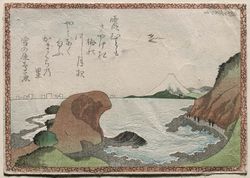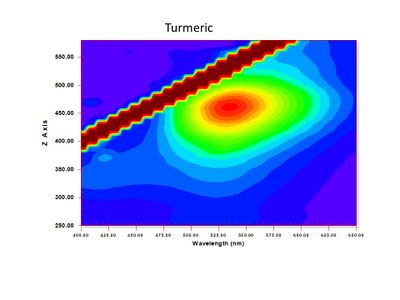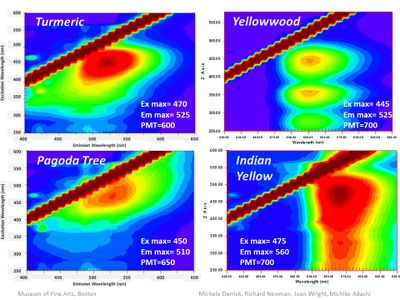Difference between revisions of "Category:Other Reds: Ukiyo-e colorant"
| Line 64: | Line 64: | ||
==List of Prints == | ==List of Prints == | ||
| − | |||
Revision as of 18:03, 13 July 2020
Other Reds: Oranges are commonly seen and created by overprinting a red and yellow colorant or through mixing these colors. Safflower and orpiment appear to be the most common combination. Other combinations of reds and yellows have also been used to create various oranges. Other combinations detected so far are:
- Safflower, orpiment
- safflower, turmeric
- safflower, flavonoid
- sappanwood, flavonoid
- red lead, orpiment
- iron oxide red, orpiment
- red lead, iron oxide yellow
For more information see:
Examples of Other greens in Ukiyo-e Prints

|

|

|

|

|
Analysis
Excitation Emission Matrix (EEM) spectroscopy can easily identify turmeric due to its high fluorescence and clear, consistent pattern. Another yellow colorant thought to have been traditionally used, Japanese yellow wood or kihada also fluoresces very brightly but they give very distinctive EEM patterns, making it easy to differentiate between the two. Yellow wood has not been detected so far.
List of Prints
Pages in category "Other Reds: Ukiyo-e colorant"
The following 26 pages are in this category, out of 26 total.
E
- Eisen, Fujieda: Kichô of the Owariya, from the series A Tôkaidô Board Game of Courtesans: Fifty-three Pairings in the Yoshiwara, 11.17946
- Eisen, Kawasaki, No. 3 from an untitled series of the Fifty-three Stations of the Tôkaidô Road, 11.25617
- Eisen, Minazuru-hime as Ono no Komachi and Benkei as Kisen Hôshi, from the series Characters from the Life of Ushiwaka as the Six Poetic Immortals, 11.25669
H
- Harunobu, Courtesan Watching Two Kamuro Make a Snow Dog, 21.4463
- Harunobu, Osen of the Kagiya and a Young Man with a Cat, 11.19496
- Hiroshige I, Naitô Shinjuku, Yotsuya, from the series One Hundred Famous Views of Edo, 11.35823
- Hokkei, Goat Standing by a Plum Tree, 21.9277
- Hokkei, Ômori, from the series Souvenirs of Enoshima, a Set of Sixteen, 11.19845
K
- Kiyomasu II, Actors Segawa Kikunojô I as Yomogiu, Ichikawa Ebizô II as Tono no Hyôe, and Yamamoto Kyôzô as Kureha, 21.5459
- Kokan, Couple Cooling Off on a Garden Bench, 11.19524
- Kunisada, Actor Sawamura Tanosuke II, from the series Actor Rebuses, 11.42324
- Kunisada, Poem by Ariwara no Narihira Ason: (Actor Ichikawa Danjûrô VIII as) Seigen, from the series Comparisons for Thirty-six Selected Poems, 11.42663
- Kunisada, Young Woman Pointing and Giggling, from the series Types of the Floating World Seen through a Physiognomist's Glass, 34.471
- Kuniyoshi, (Actor Ichikawa Ebizô V as) Inuyama Dôsetsu, from the series The Lives of Eight Brave and Loyal Dog Heroes, 11.28841
- Kuniyoshi, Actor Ichikawa Kodanji IV as the Ghost of Asakura Tôgo, 11.30460
- Kuniyoshi, Drying Board Suggesting Hiyodorigoe, from the series Women in Benkei-checked Fabrics, 11.36363
- Kuniyoshi, Takeout Sushi Suggesting Ataka, from the series Women in Benkei-checked Fabrics, 11.36360
- Kuniyoshi, Tsumagome: Abe no Yasuna and the Fox Kuzunoha, from the series Sixty-nine Stations of the Kisokaidô Road, 11.41803
S
- Sharaku, Actor Osagawa Tsuneyo II as Ippei's Older Sister Osan, 11.14673
- Sharaku, Actor Osagawa Tsuneyo II as Ippei's Older Sister Osan, 11.14674
- Sharaku, Actor Osagawa Tsuneyo II as Ippei's Older Sister Osan, 21.7244
- Sharaku, Actors Ichikawa Komazô III as Kameya Chûbei and Nakayama Tomisaburô I as Umegawa, 21.7236
- Shinsai, Chapters 25–27, from the series The Tale of Genji, 21.9264



